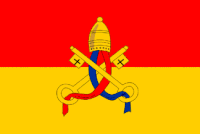March of Ancona
This article relies largely or entirely on a single source. (July 2013) |


The March of Ancona (Italian: Marca Anconitana) (also Anconetana) was a frontier march centred on the city of Ancona and, then, Macerata in the Middle Ages.[1] Its name is preserved as an Italian region today, the Marches, and it corresponds to almost the entire modern region and not just the Province of Ancona.
The march was created as a political division of the Papal States during the pontificate of Innocent III in the year 1198. It was initially governed by a papal nominee called a rector. The rector of Ancona, like the rectors of the other papal provinces, was under the authority of a general rector reporting directly to the pope. The province was confirmed by the Constitutiones Sanctæ Matris Ecclesiæ in 1357. The march followed the Adriatic as far north as Urbino and contained the cities of Loreto, Camerino, Fermo, Macerata, Osimo, San Severino, and Tolentino
According to Paul Sabatier's biography of St. Francis of Assisi, "The Road to Assisi", the March of Ancona became the home of the spiritual Franciscans after Francis' death.
Rulers
- Alberto Azzo I d'Este (1013-1029)
- Markward von Annweiler (1184-1202)
- Azzo VI d'Este (1210-1212)
- Aldobrandino I d'Este (1212-1215)
- Azzo VII d'Este (1215-1264)
- Obizzo II d'Este (1264-1293)
- Azzo VIII d'Este, Aldobrandino II d'Este and Francesco d'Este (1293-1308)
- Aldobrandino II d'Este and Francesco d'Este (1308-1312)
- Aldobrandino II d'Este (1312-1326)
- Francesco I Sforza (1434-1443)
References
